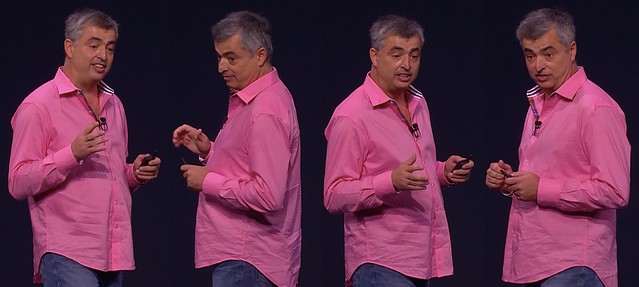Post mortem
September 10, 2014 at 11:34 PM by Dr. Drang
The first 30 minutes or so of yesterday’s Apple event were, for those of us viewing it remotely, a psychedelic mix of color bars, sudden jumps forward and backward in time, and simultaneous Mandarin translation. I was so distracted by the video stream’s bizarre behavior I didn’t get a chance to tweet about Phil Schiller’s shirt-tuckedness. Fortunately, Jason Snell, Serenity Caldwell, and Dan Moren were live-blogging at the Macworld site so we could keep up until the stream settled down. I’m sure the higher-ups at IDG will reward them handsomely for the vital service they provided.
The iPhone 6 and 6 Plus were about what we expected. Bigger screens, better cameras, (somewhat) faster processors. The shift in storage sizes from 16/32/64 to 16/64/128 was a little weird, and those who were expecting sapphire screens were probably disappointed (they shouldn’t be—Gorilla Glass is amazing stuff). Overall, a solid upgrade, and they’ll sell like crazy as they always do.
One thing I’m looking forward to is seeing how sales of the 6 and 6 Plus compare. Not that I care about sales per se, I just like seeing the failed predictions of tech journalists who think they have their fingers on the pulse of the market. Last year, many pundits confidently predicted that the 5C would be the big seller based on nothing more than a kind of sneering view of “normal people” who—unlike the pundits themselves—don’t understand the hardware well enough to get the best. This year, the early predictions are that the 6 will be the big seller because it’s for normal people. We’ll see.
The Apple Watch is an impressive piece of technology and looks to be very well thought out. But Ben Thompson is exactly right when he says the presentation didn’t do a particularly good job of explaining why we should go out and get one. He contrasts yesterday’s event with the introductions of the iPod, the iPhone, and the iPad. I didn’t see the iPod event, but I can tell you I wanted both the iPhone and the iPad after seeing their introductions. Not so with the watch. Initial impressions can change—I never did get an iPad—but right now I see myself admiring Apple Watches, not buying one.
To me, the most impressive part of the event was the most unlikely one: the introduction of Apple Pay. This is not because of my fascination with Eddy Cue,
but because he had a good story and he told it well.
I’m not a security expert, but the stuff about generating one-time payment codes and not storing the card numbers themselves sounded like good ideas to me. Particularly effective were the slides that said
- Apple doesn’t know what you bought.
- Apple doesn’t know where you bought it.
- Apple doesn’t know how much you paid for it.
- Cashier doesn’t see your name.
- Cashier doesn’t see your card number.
- Cashier doesn’t see your security code.
I may be especially receptive to this pitch because of what’s happened to my wife and me this year. At the beginning of the year, we were issued new credit cards because of the Target breach. We went through the long process of changing our card information at all of our online and automatic payment accounts. A few months later, Chase caught a fraudulent use of our new card number, and we had to go through the process again. The recent news about a breach at Home Depot has me expecting another go-round. That’ll be three new cards issued in one year. We haven’t lost any money in these incidents, but we’ve lost time.
I know that Apple Pay won’t prevent this from happening again. Still, the more we’re able to use it, the less exposure our card number gets, and that can only be good. It’s an unexpected plus for the new iPhones.
Update 9/11/14
Unsurprisingly, Myke Hurley was also interested in Apple Pay. He’s talked about the contactless payment systems used in Europe in the past and discusses Apple Pay in that context in the most recent episode of Connected.

